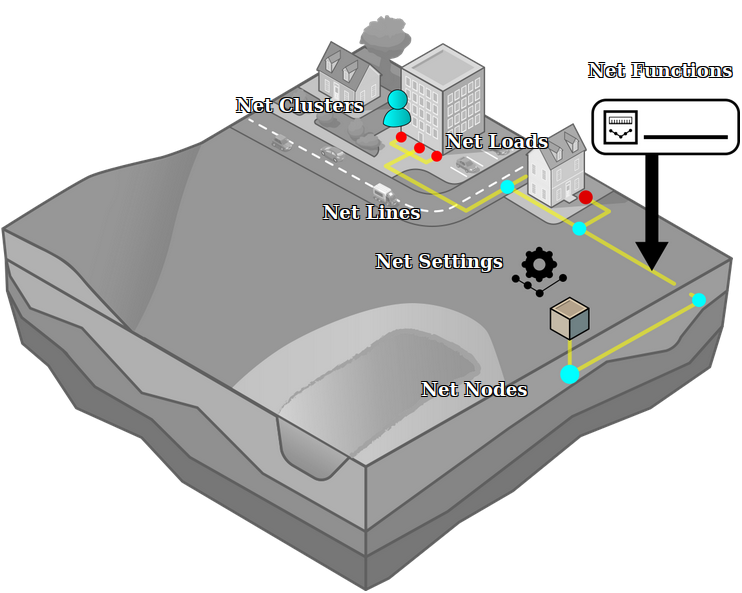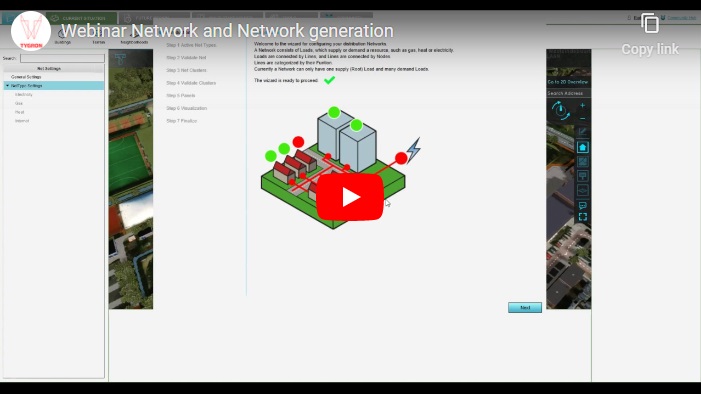Network: Difference between revisions
| Line 33: | Line 33: | ||
* [[How to import an existing network]] | * [[How to import an existing network]] | ||
* [[How to manually edit a network]] | * [[How to manually edit a network]] | ||
===Checking for errors=== | ===Checking for errors=== | ||
Revision as of 13:51, 7 October 2022

Networks in the platform are composed of multiple constituent components:
- Net Type: A categorization of the network.
- Net Nodes: A node present in one or more networks
- Net Lines: A connection between two net nodes
- Has an associated net function, which in turn is related to a specific net type.
- Net Loads: A definition of supply or demand in the network
- Net Clusters: Cluster of net loads that provides group (de)activation.
- Net Settings: Settings related to the configuration of a Network of a specific Net Type.
Net type
Each network is related to a predefined resource type. This is known as the net type. The network then is the system through which resources travels from elements of supply to elements of demand. Each network of a separate type is a separate entity, and networks of different types do not affect each other. The following network types are currently available:
- ELECTRICITY
- GAS
- HEAT
- INTERNET
- SEWER
Restrictions on networks
- Networks cannot contain any cycles. All networks should be defined as a tree. If the network is not structured as a tree, network generation and other calculations may have unexpected results.
- A net node can be connected to 1, 2, or more net lines, except when that node is a load node. In that case, a net node can only be connected to exactly 1 net line.
- Behavior for networks linked with buildings which are altered during a session are undefined. When using network functionality, the buildings linked to by the network should not be demolished, upgraded, sold to other stakeholders, or otherwise changed.
How-to's
- How to generate a network using the network wizard
- How to import an existing network
- How to manually edit a network
Checking for errors
When there is doubt on whether the network has been created correctly, there are options to have the Tygron Platform check for issues automatically.
Network wizard
When creating or importing network data using the net wizard, but also when stepping through the available steps of the wizard without effecting any changes, there are 2 validation steps where all preceding information is checked. These validation steps will check the following for all active network types:
- There is a root node
- All net lines are connected directly or indirectly to the root node
- All net loads are connected via paths composed of net lines to the root note
- All net nodes with only 1 net line connected to them have a net load connected to them
- All net nodes with a net load connected to them only have 1 net line connected to them
- All net loads are part of a cluster
Net validation
The net validation panel will check the following for a given network type:
- There is a root node
- All net lines are connected directly or indirectly to the root node
- All net nodes with only 1 net line connected to them have a net load connected to them
- All net nodes with a net load connected to them only have 1 net line connected to them
You will also be able to "highlight" the network. This will highlight all segments of the network that are connected to the root node. All sections of the network that aren't connected in any way to the root node are not connected. This allows you to find small fractures which disconnect sections of the network.
See Also
